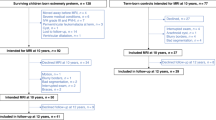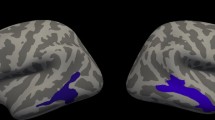Abstract
One primary problem in extremely preterm children is the occurrence of atypical language development. The aim of this study was to explore the components of language (articulatory phonetics, lexicon and syntax) in comprehension and production in extremely preterm children between the 4th and 5th year of age. The language section of the Preschool Neuropsychological Test was administered to 20 extremely preterm monolingual Italian children (GA < 28 weeks) and to a control sample of 40 full term children (GA > 37 weeks), matched for age and non-verbal IQ. Language comprehension was fully efficient in all of the components that we assessed. In the tasks of language production the clinical sample fared much worse than their age and IQ matched controls and the differences were highly significant (p < .001). Language acquisition in extremely preterm children may follow uneven developmental trajectories: language comprehension can be spared in the face of a selective impairment of language production at the level of articulatory phonetics and syntax.



Similar content being viewed by others
References
Anderson, P., Doyle, L. W., & Victorian Infant Collaborative Study Group. (2003). Neurobehavioral outcomes of school-age children born extremely low birth weight or very preterm in the 1990s. JAMA, 289(24), 3264–3272.
Basili, F., Cocchi, M., Di Rosa, A., & Tamburini, C. (2010). Certificato di Assistenza al Parto (CeDAP): Analisi dell’evento nascita—Anno 2010. Roma: Ministero della Salute.
Beck, S., Wojdyla, D., Say, L., Betran, A. P., Merialdi, M., Requejo, J. H., et al. (2010). The world-wide incidence of preterm birth: A systematic review of maternal mortality and morbidity. Bulletin of the World Health Organization, 88(1), 31–38.
Benassi, E., Savini, S., Iverson, J. M., Guarini, A., Caselli, M. C., Alessandroni, R., et al. (2015). Early communicative behaviors and their relationship to motor skills in extremely preterm infants. Research in Developmental Disabilities, 48, 132–144.
Blencowe, H., Cousens, S., Oestergaard, M. Z., Chou, D., Moller, A. B., Narwal, R., et al. (2012). National, regional, and worldwide estimates of preterm birth rates in the year 2010 with time trends since 1990 for selected countries: A systematic analysis and implications. Lancet, 379(9832), 2162–2172.
Bloom, P. (2000). How children learn the meanings of words. Cambridge, MA: MIT Press.
Briscoe, J., Gathercole, S., & Marlow, N. (2001). Everyday memory and cognitive ability in children born very prematurely. Journal of Child Psychology and Psychiatry and Allied Disciplines, 42(6), 749–754.
Briscoe, J., Gathercole, S. E., & Marlow, N. (1998). Short-term memory and language outcomes after extreme prematurity at birth. Journal of Speech Language & Hearing Research, 41(3), 654–666.
Cossu, G., & Paris, E. (2007). Test Neuropsicologico Prescolare. Florence: Giunti O.S.
Dall’Oglio, A. M., Rossiello, B., Coletti, M. F., Bultrini, M., De Marchis, C., Ravà, L., et al. (2010). Do healthy preterm children need neuropsychological follow-up? Preschool outcomes compared with term peers. Developmental Medicine and Child Neurology, 52(10), 955–961.
D’Odorico, L., Majorano, M., Fasolo, M., Salerni, N., & Suttora, C. (2011). Characteristics of phonological development as a risk factor for language development in Italian-speaking pre-term children: A longitudinal study. Clinical Linguistics & Phonetics, 25(1), 53–65.
Fellman, V., Hellström-Westas, L., Norman, M., Westgren, M., Källén, K., Lagercrantz, H., et al. (2009). One-year survival of extremely pre- term infants after active perinatal care in Sweden. JAMA, 301(21), 2225–2233.
Foster-Cohen, S., Edgin, J. O., Champion, P. R., & Woodward, L. J. (2007). Early delayed language development in very preterm infants: Evidence from the MacArthur-Bates CDI. Journal of Child Language, 34(3), 655–675.
Guarini, A., Sansavini, A., Fabbri, C., Alessandroni, R., Faldella, G., & Karmiloff-Smith, A. (2009). Reconsidering the impact of preterm birth on language outcome. Early Human Development, 85(10), 639–645.
Guarini, A., Sansavini, A., Fabbri, C., Savini, S., Alessandroni, R., Faldella, G., et al. (2010). Long-term effects of preterm birth on language and literacy at eight years. Journal of Child Language, 37(4), 865–885.
Herold, B., Höhle, B., Walch, E., Weber, T., & Obladen, M. (2008). Impaired word stress pattern discrimination in very-low-birthweight infants during the first 6 months of life. Developmental Medicine and Child Neurology, 50(9), 678–683.
Heron, M., Sutton, P. D., Xu, J., Ventura, S. J., Strobino, D. M., & Guyer, B. (2010). Annual summary of vital statistics: 2007. Pediatrics, 125(1), 4–15.
Howard, K., Roberts, G., Lim, J., Lee, K. J., Barre, N., Treyvaud, K., et al. (2011). Biological and environmental factors as predictors of language skills in very preterm children at 5 years of age. Journal of Developmental and Behavioral Pediatrics, 32(3), 239–249.
Iwata, S., Nakamura, T., Hizume, E., Kihara, H., Takashima, S., Matsuishi, T., et al. (2012). Qualitative brain MRI at term and cognitive outcomes at 9 years after very preterm birth. Pediatrics, 129(5), e1138–e1147.
Jansson-Verkasalo, E., Ruusuvirta, T., Huotilainen, M., Alku, P., Kushnerenko, E., Suominen, K., et al. (2010). Atypical perceptual narrowing in prematurely born infants is associated with compromised language acquisition at 2 years of age. BMC Neuroscience, 11, 88–94.
Kunnari, S., Yliherva, A., Paavola, L., & Peltoniemi, O. M. (2012). Expressive language skills in Finnish two-year-old extremely- and very-low-birth-weight preterm children. Journal of Learning Disabilities, 64(1), 5–11.
Landry, S., Smith, K., & Swank, P. (2002). Environmental effects on language development in normal and high-risk child populations. Seminars in Pediatric Neurology, 9(3), 192–200.
Luoma, L., Herrgård, E., Martikainen, A., & Ahonen, T. (1998). Speech and language development of children born at < or = 32 weeks’ gestation: A 5 year prospective follow-up study. Developmental Medicine and Child Neurology, 40(6), 380–387.
Luu, T. M., Ment, L. R., Schneider, K. C., Katz, K. H., Allan, W. C., & Vohr, B. R. (2009). Lasting effects of preterm birth and neonatal brain hemorrhage at 12 years of age. Pediatrics, 123(3), 1037–1044.
Luu, T. M., Vohr, B. R., Allan, W., Schneider, K. C., & Ment, L. R. (2011). Evidence for catch-up in cognition and receptive vocabulary among adolescents born very preterm. Pediatrics, 128(2), 313–322.
Markestad, T., Kaaresen, P. I., Rønnestad, A., Reigstad, H., Lossius, K., Medbø, S., et al. (2005). Early death, morbidity, and need of treatment among extremely premature infants. Pediatrics, 115(5), 1289–1298.
Marlow, N., Hennessy, E. M., Bracewell, M. A., Wolke, D., & EPICure Study Group. (2007). Motor and executive function at 6 years of age after extremely preterm birth. Pediatrics, 120(4), 793–805.
Noort-van, Van, der Spek, I., Franken, M. J. P., & Weisglas- Kuperus, N. (2012). Language functions in preterm-born children: A systematic review and meta-analysis. Pediatrics, 129(4), 745–754. https://doi.org/10.1542/peds.2011-1728.
Paquette, N., Vannasing, P., Tremblay, J., Lefebvre, F., Roy, M. S., McKerral, M., et al. (2015). Early electrophysiological markers of atypical language processing in prematurely born infants. Neuropsychologia, 79(Pt A), 21–32.
Raven, J. C. (1984). CPM coloured progressive matrices. Florence: Giunti O.S.
Reidy, N., Morgan, A., Thompson, D. K., Inder, T. E., Doyle, L. W., & Anderson, P. J. (2013). Impaired language abilities and white matter abnormalities in children born very preterm and/or very low birth weight. Journal of Pediatrics, 162(4), 719–724.
Ronconi, A., Corchia, C., Bellù, R., Gagliardi, L., Mosca, F., Zanini, R., et al. (2008). Esiti dei neonati di basso peso nelle Terapie Intensive Neonatali partecipanti all’Italian Neonatal Network nel 2008. Roma: Istituto Superiore di Sanità.
Roze, E., Van Braeckel, K. N. J. A., van der Veere, C. N., Maathuis, C. G., Martijn, A., & Bos, A. F. (2009). Functional outcome at school age of preterm infants with periventricular hemorrhagic infarction. Pediatrics, 123(6), 1493–1500.
Saavalainen, P., Luoma, L., Bowler, D., Timonen, T., Määttä, S., Laukkanen, E., et al. (2006). Naming skills of children born preterm in comparison with their term peers at the ages of 9 and 16 years. Developmental Medicine and Child Neurology, 48(1), 28–32.
Saigal, S., & Doyle, L. W. (2008). An overview of mortality and sequelae of preterm birth from infancy to adulthood. Lancet, 371(9608), 261–269.
Sansavini, A., Guarini, A., Justice, L. M., Savini, S., Broccoli, S., Alessandroni, R., et al. (2010). Does preterm birth increase a child’s risk for language impairment? Early Human Development, 86(12), 765–772.
Sansavini, A., Guarini, A., Savini, S., Broccoli, S., Justice, L., Alessandroni, R., et al. (2011). Longitudinal trajectories of gestural and linguistic abilities in very preterm infants in the second year of life. Neuropsychologia, 49(13), 3677–3688.
Serenius, F., Kallén, K., Blennow, M., Ewald, U., Fellman, V., Holmström, G., et al. (2013). Neurodevelopmental outcome in extremely preterm infants at 2.5 years after active perinatal care in Sweden. JAMA, 309(17), 1810–1820.
Shapiro, K. B. (2004). Cerebral palsy: a reconceptualization of the spectrum. Journal of Peadiatrics, 145(2 Suppl), 83–87.
Stoll, B. J., Hansen, N. I., Bell, E. F., Shankaran, S., Laptook, A. R., Walsh, M. C., et al. (2010). Neonatal outcomes of extremely preterm infants from the NICHD Neonatal Research Network. Pediatrics, 126(3), 443–456.
Taylor, G. H., Klein, N., Minich, N. M., & Hack, M. (2000). Verbal Memory Deficits in Children with Less than 750 g Birth Weight. Child Neuropsychology, 6(1), 49–63.
Tommiska, V., Heinonen, K., Lehtonen, L., Renlund, M., Saarela, T., Tammela, O., et al. (2007). No improvement in outcome of nationwide extremely low birth weight infant populations between 1996–1997 and 1999–2000. Pediatrics, 119(1), 29–36.
Törölä, H., Lehtihalmes, M., Heikkinen, H., Olsén, P., & Yliherva, A. (2012a). Early vocalization of preterm infants with extremely low birth weight (ELBW), part I: From birth to expansion stage. Clinical Linguistics & Phonetics, 26(4), 330–444.
Törölä, H., Lehtihalmes, M., Heikkinen, H., Olsén, P., & Yliherva, A. (2012b). Early vocalization of preterm infants with extremely low birth weight (ELBW), part II: From canonical babbling up to the appearance of the first word. Clinical Linguistics & Phonetics, 26(4), 345–356.
Towen, B. C. L. (1970). The neurological examination of the child with minor nervous dysfunction. Philadelphia: Lippincott.
Vohr, B. R., Wright, L. L., Dusick, A. M., Mele, L., Verter, J., Steichen, J. J., et al. (2000). Neurodevelopmental and functional outcomes of extremely low birth weight infants in the National Institute of Child Health and Human Development Neonatal Research Network, 1993-1994. Pediatrics, 105(6), 1216–1226.
Wechsler, D. (2002). Wechsler pre-school and primary scale of intelligence (III ed.). Florence: Giunti O.S.
Wolke, D., & Meyer, R. (1999). Cognitive status, language attainment and prereading skills of 6-year-old very preterm children and their peers: the Bavarian longitudinal study. Developmental Medicine and Child Neurology, 41(2), 94–109.
Woodward, L. J., Moor, S., Hood, K. M., Champion, P. R., Foster-Cohen, S., Inder, T. E., et al. (2009). Very preterm children show impairments across multiple neurodevelopmental domains by age 4 years. Archives of Disease in Childhood- Fetal and Neonatal Edition, 94(5), F339–F344.
Funding
No funding was secured for this study
Author information
Authors and Affiliations
Corresponding author
Ethics declarations
Conflict of interest
The authors have no conflicts of interest.
Additional information
Publisher's Note
Springer Nature remains neutral with regard to jurisdictional claims in published maps and institutional affiliations.
Rights and permissions
About this article
Cite this article
De Stefano, P., Marchignoli, M., Pisani, F. et al. Uneven Linguistic Outcome in Extremely Preterm Children. J Psycholinguist Res 48, 1363–1375 (2019). https://doi.org/10.1007/s10936-019-09662-x
Published:
Issue Date:
DOI: https://doi.org/10.1007/s10936-019-09662-x




